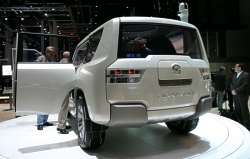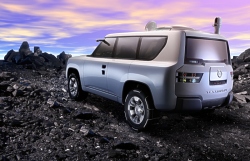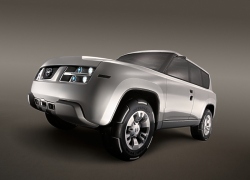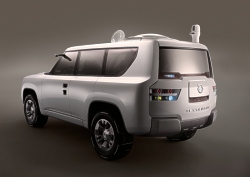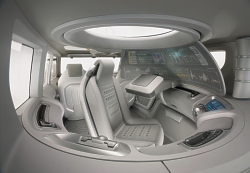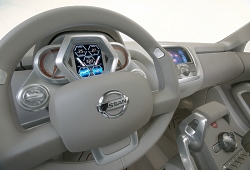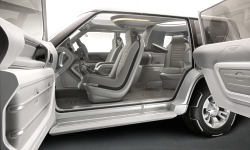
.
. .
..
. . . .
Related Topics:
© 1998 - 2004 Copyright
& |
Nissan: Terranaut Concept
“The Terranaut will protect its occupants from the extremes of the world’s environments and, on the other hand, allow you to be part of it.” François Bancon, General Manager, Motor-Show, Exploratory & Advanced Product Planning, Nissan Motor Limited. Measuring 4,965mm from stem to stern, the advanced four-wheel-drive explorer stands 2,150mm tall and is 2,100mm wide. These impressive external dimensions provide Terranaut with the interior space needed to house its laboratory equipment and scientist.
By hinging the doors at the front and rear respectively, ingress and egress is made easy: an important consideration when the occupants are likely to be wearing many layers of protective clothing. With both doors open, virtually the entire side of the car becomes an entrance to the cabin while a step built in to the substantial sill folds down to ease access still further. There’s no conventional door at the back of Terranaut, either. Instead, centrally placed in the rear is an integrated air lock drawer into which the pilot or co-pilot outside the vehicle can place samples for clinical analysis by the scientist left inside the cabin. As well as providing excellent visibility out of the vehicle, the deep rear window also houses external displays and touch screens for data access by those outside the vehicle. Excellent all-round visibility is also afforded by the deep side and front windows, while much of the roof area above the two front seats is glazed, too. All the glass is highly reflective thus maintaining a controlled atmosphere within the cabin by reflecting external light sources, whether it be from the sun or glare from snow and ice. Even the body paintwork takes into consideration of the often hostile environments in which Terranaut is likely to find itself – taking its lead from the aircraft industry, the paint can withstand extremes of temperature. The off-white finish contrasts dramatically with the almost mirror-finish bronze glasshouse, the overall effect being reminiscent of a space craft. Huge wheels are covered by tyres specially constructed for Terranaut by Goodyear. Puncture proof, they function as conventional road tyres when the vehicle is being driven on metalled roads but, by changing air pressure, transform themselves into chunky off-road tyres. The exterior of Terranaut is dominated, however, by a glass dome over the rear portion of the roof and which marks the uppermost element of Terranaut’s science laboratory. As well as providing a window on the world for the occupants inside, the sphere doubles as an escape hatch should the ground beneath the vehicle give way for any reason. Other features to be found on the roof are a circular housing for satellite positioning, transmitting and scanning equipment and a telescopic arm onto which a day/night view camera can be mounted. When fully extended this can transmit 360-degree ‘helicopter view’ images from around Terranaut to the vehicle itself and to expedition headquarters at all hours of the night and day. Inside the vehicle, the spherical science laboratory dominates the entire cabin area behind the two front seats. A single revolving seat with an integrated computer keyboard is situated beneath the glass roof dome and gives the scientist complete 360-degree access to the various workstations found in Terranaut. The laboratory also incorporates a hemispherical display in front of the revolving seat which acts as a computer screen and data display panel – created in collaboration with Elumens – and onto which can also be relayed images transmitted from the cameras attached to the vehicle. Images and data can be downloaded to both computer storage systems and to an on-board high definition printer. Although designed as a mobile laboratory, NDE’s project team of six designers has ensured the vehicle provides a welcoming habitat for the three-man Terranaut team. While functional materials have been used extensively inside the cabin – the totally flat floor, for example, has an easy-to-clean rubberised covering – all surfaces with which the occupants are likely to come into contact feature soft-touch materials. Touch pads used to open the doors electrically are covered with a tactile silicon finish while the seats, which all feature air vents in the base and backrests feature ‘breathing’ fabrics. Colours chosen mix practical laboratory greys with warm beige and brown shades to bring a human touch to what is essentially a scientific environment. Reflecting the sorts of samples that might be brought into the laboratory for analysis, the design team have adopted the hexagon – the geometric shape of one of the seven crystal systems – as a styling feature. The light clusters, front and rear, are all hexagonal while the jewel-like lights themselves appear to be actual gemstones. Raised hexagonal sections on the flooring provide extra grip inside the cabin, while even the two sides of the dashboard and the centre console between pilot and co-pilot adopt the six-sided theme. Designer Felipe Roo Clefas says: “Terranaut is very much a statement about how the 4x4 can help us discover more about our world.” “At first glance it might appear that Pivo and Terranaut have little in common,” says Carlos Tavares, “but the philosophy behind them both proves otherwise. For both Pivo and Terranaut mix advanced engineering with imagination. As a result both SHIFT_access… and that’s something Nissan’s inspired designers and product planners will continue to do.” photos: Nissan, Automotive Intelligence
|
.
.
|










